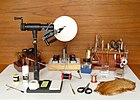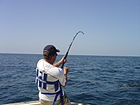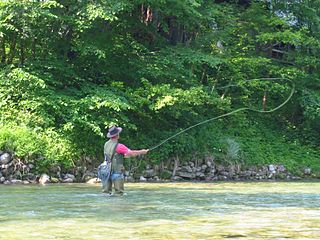
Fly fishing is an angling technique that uses a ultralight-weight lure called an artificial fly, which typically mimics small invertebrates such as flying and aquatic insects to attract and catch fish. Because the mass of the fly lure is insufficient to overcome air resistance, it cannot be launched far using conventional gears and techniques, so specialized tackles are used instead and the casting techniques are significantly different from other forms of angling. It is also very common for the angler to wear waders, carry a hand net, and stand in the water when fishing.

Recreational fishing, also called sport fishing or game fishing, is fishing for leisure, exercise or competition. It can be contrasted with commercial fishing, which is professional fishing for profit; or subsistence fishing, which is fishing for survival and livelihood.

An artificial fly or fly lure is a type of fishing lure, usually used in the sport of fly fishing. In general, artificial flies are an imitation of aquatic insects that are natural food of the target fish species the fly fishers try to catch. Artificial flies are constructed by fly tying, in which furs, feathers, thread or any of very many other materials are tied onto a fish hook.
The Catskill Fly Fishing Center and Museum is a nonprofit, educational organization dedicated to: preserving America's fly fishing heritage; teaching its future generations of fly fishers; and protecting its fly fishing environment. The museum is located along Willowemoc Creek in the heart of the Catskills at 1031 Old Route 17 in Livingston Manor, New York.
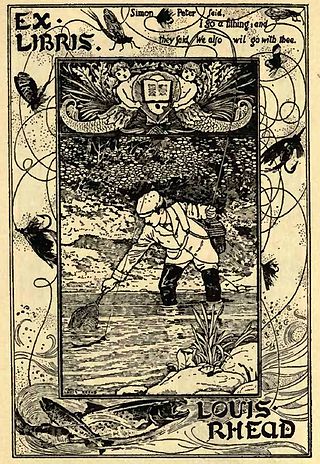
This general annotated bibliography page provides an overview of notable and not so notable works in the English language regarding the sport of fly fishing, listed by year of first publication. Although not all the listed books are devoted exclusively to fly fishing, all these titles contain significant fly fishing content. The focus of the present page is on classic general texts on fly fishing and its history, together with notable public or university library collections dedicated to fly fishing.

Fishing is a prehistoric practice dating back at least 40,000 years. Since the 16th century, fishing vessels have been able to cross oceans in pursuit of fish, and since the 19th century it has been possible to use larger vessels and in some cases process the fish on board. Fish are normally caught in the wild. Techniques for catching fish include hand gathering, spearing, netting, angling and trapping.

Frederic Maurice Halford, pseudonym Detached Badger, was a wealthy and influential British angler and fly fishing author. Halford is most noted for his development and promotion of the dry fly technique on English chalk streams. He is generally accepted as "The Father of Modern Dry Fly Fishing". John Waller Hills, A History of Fly Fishing for Trout (1921) called Halford "The Historian of the Dry Fly".

George Edward MacKenzie Skues, usually known as G. E. M. Skues (1858–1949), was a British lawyer, author and fly fisherman most noted for the invention of modern-day nymph fishing and the controversy it caused with the Chalk stream dry fly doctrine developed by Frederic M. Halford. His second book, The Way of a Trout with a Fly (1921) is considered a seminal work on nymph fishing. According to Dr Andrew Herd, the British fly fishing historian, Skues:
was, without any doubt, one of the greatest trout fishermen that ever lived. His achievement was the invention of fly fishing with the nymph, a discovery that put a full stop to half a century of stagnation in wet fly fishing for trout, and formed the bedrock for modern sunk fly fishing. Skues' achievement was not without controversy, and provoked what was perhaps the most bitter dispute in fly fishing history.

Minor Tactics of the Chalk Stream and Kindred Studies is a fly fishing book written by G. E. M. Skues published in London in 1910. Minor Tactics was Skues's first book and set the stage for his ascendancy as the inventor of nymph fishing for trout.
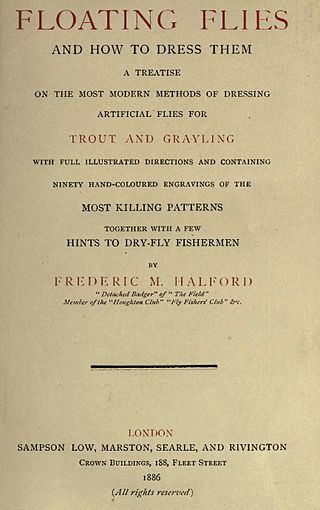
Floating Flies and How to Dress Them - A Treatise on the Most Modern Methods of Dressing Artificial Flies for Trout and Grayling with Full Illustrated Directions and Containing Ninety Hand-Coloured Engravings of the Most Killing Patterns Together with a Few Hints to Dry-Fly Fishermen is a fly fishing book written by Frederic M. Halford published in London in April 1886 by Sampson Low. A deluxe edition on large paper sold out before publication and the trade edition of 500 nearly so.

Favorite Flies and Their Histories - With many replies from practical anglers to inquiries concerning how, when and where to use them-Illustrated by Thirty-two colored plates of flies, six engravings of natural insects and eight reproductions of photographs is a fly fishing book written by Mary Orvis Marbury published in Boston in April 1892 by Houghton Mifflin. It was considered by most fly fishers as the standard reference on flies in its era.

The Salmon Fly - How to Dress It and How to Use It is a fly fishing book written by George M. Kelson published in London in 1895 by Messers. Wyman & Sons, Limited. This Victorian guide to fly fish tying built up the illusion that angling for salmon required feathers of exotic bird species.
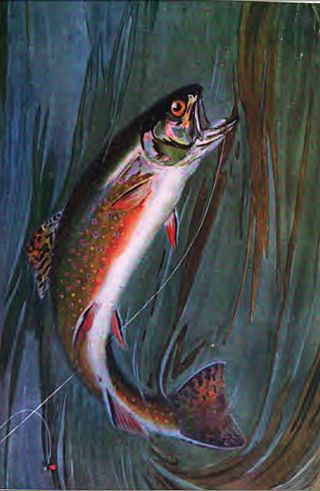
This annotated bibliography is intended to list both notable and not so notable works of English language, non-fiction and fiction related to the sport of fly fishing listed by year published. Although 100% of any book listed is not necessarily devoted to fly fishing, all these titles have significant fly fishing content. Included in this bibliography is a list of species related fly fishing literature.

This annotated bibliography is intended to list both notable and not so notable works of English language, non-fiction and fiction related to the sport of fly fishing listed by year published. Although 100% of any book listed is not necessarily devoted to fly fishing, all these titles have significant fly fishing content. Included in this bibliography is a list of fly tying, fly tackle, regional guides, memoirs, stories and fly fishing fiction related literature.
Fly Fishers International (FFI) is an international 501(c)(3) non-profit organization headquartered in Livingston, Montana. It was founded in 1964 and was formalised a year later in 1965. FFI is an organized voice for fly fishers around the world; they represent all aspects of fly fishing, which include the art of fly tying, casting, protection of the natural systems that support healthy fisheries and their habitats; which is essential to the sport. Today, the organization's goals are to ensure the legacy of fly fishing worldwide. They focus on conservation, education and a sense of community.

The Fly-Fisher's Entomology, Illustrated by Coloured Representations of the Natural and Artificial Insect and Accompanied by a Few Observations and Instructions Relative to Trout-and-Grayling Fishing, first published in 1836 by Alfred Ronalds (1802–1860), was the first comprehensive work related to the entomology associated with fly fishing. Although the work was Ronalds' only book, it was published in 11 editions between 1836 and 1913 and has been extensively reprinted in the last 100 years.
Paul Schullery was born in Middletown, Pennsylvania in 1948. He now lives in Bozeman, Montana. He has always been an avid hiker, fly fisher, photographer, wildlife watcher and has continuously documented his experience in his writing. Today, he is the author, co-author or editor of more than 40 books and numerous articles. His main focus for his works has to do with nature and our relationship with it as well as the wonders it presents us with now. Schullery studied American History at Wittenberg University and Ohio University, receiving his M.A. and B.A., respectively.

The Adams is a traditional dry fly primarily used for trout. It is considered a general imitation of an adult mayfly, flying caddis or midge. It was designed by Leonard Halladay from Mayfield, Michigan in 1922, at the request of his friend Charles Adams. The Adams has been considered one of the most popular, versatile, effective and best selling dry flies since its creation.
The Trout and Salmonid Collection is a special collection of literature and archives in the Montana State University Library's Merrill G. Burlingame Special Collections Library. The collection is also known as The Bud Lilly Trout and Salmonid Bibliography, named after founder Bud Lilly. The approximately 11,000-volume collection, established in 1999, is devoted to preserving literary, scientific, government and media resources related to all aspects of trout and other salmonids. The collection contains materials in many languages and is not restricted by geography. It is considered a world-class collection of international significance relative to the study of trout and salmonids.





















